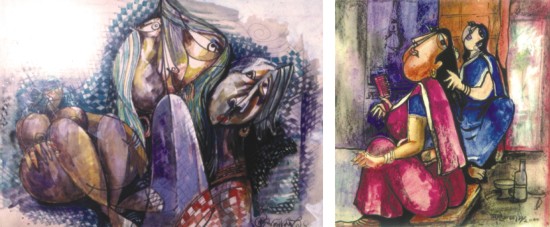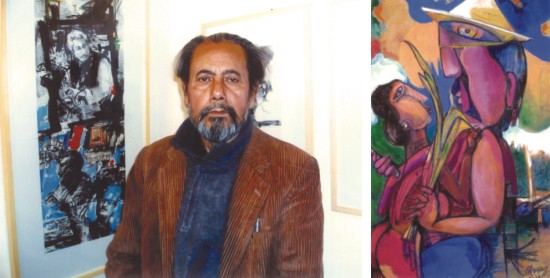Achievement
Seventy-Seven Colourful Years
Anika Hossain
Those who have not had the opportunity to view artist Nurul Islam's spectacular work will be struck by his style, composition and versatility. His use of large canvases and raw, untoned colours is striking to the eye. Upon a closer look there is much more to appreciate. Unlike many in his profession, he has developed a signature style with his use of space, subjects and folk motifs. This artist, who belonged to the third batch of students graduating from Dhaka Art Institute in 1956 has been virtually overlooked by notables of the art circle. His works have not been presented to the public as frequently as those of his colleagues', both his contemporaries and those younger than him. Whatever the reasons for this neglect may have been, the lack of talent and dedication were not amongst them. Seventy-seven this year, the artist is celebrating his birthday by exhibiting seventy seven of his most magnificent works at the Shilpakala Academy giving the art circle and the public yet another chance to appreciate what they have been missing. This will be the sixth solo art exhibition of his career which began 54 years ago.
Each of Islam's awe-inspiring pieces has a story hidden inside. The artist incorporates folklore and legends into his paintings, most of which depict the lush rural life of Bangladesh adding a magical sense of grandeur to his creations. The majority of his works are paintings, in oils, acrylic and tempera. His favourite subjects are figurative and mostly of women accompanied by folk motifs like birds, butterflies, fish, flowers, etc. The rich, beautiful mixture of colours and the voluptuous figures, symbolising fertility, with fragmented and elongated body parts, give his paintings a dreamlike quality.
"Muktijuddha", one of Islam's large, magnificent semi-abstract creations, tells the story of the abuse women had to endure by the occupation army in 1971. The use of darker colours gives off an aura of pain and suffering and the expressions on the faces of each subject is brilliantly detailed, showing cruelty in the expressions of the oppressors and the terror in the eyes of the oppressed.
Although oils are representative of most of his work, Islam's watercolours and line drawings are equally mesmerising. Islam admits that his style has evolved over the years and of late, he has been using more abstract or semi-abstract images in his paintings. He says, this is due to the fact that ever since photography has gained popularity, realism in art has lost much of its charm.
The figures in Islam's line drawings seem to merge in and out of each other, creating rhythm and harmony. In his line and watercolour piece, "A Woman At Rest", Islam has created the entire drawing without lifting his pen from the canvas. Islam claims that he adopts his style from the famous artist Kamrul Hasan and his inspiration for his subjects comes from the renowned artist Joynul Abedin. Islam also claims to be greatly influenced by the works of his favourite artists Jamini Roy, Qamrul Hasan and Nandalal Basu.
 |
| Three Women |
Hair Dressing |
On August 14, 1947, Islam won his first art competition at school, while he was in the seventh grade. This was the beginning of his long winding and difficult career as an artist.
His first solo exhibition was held at the East Pakistan Arts Council (now Shilpakala Academy) in 1964. This was the first time a Bangali artist was exhibiting solo. The inauguration of this exhibition was conducted by the then Speaker of the East Pakistan Assembly, Abdul Hamid Chowdhury, father of Abu Said Chowdury, Bangladesh's first president. The exhibition was attended by many of the dignitaries who had come to Dhaka for the opening of the East Pakistan Television House. It was at this exhibition that Islam met the famous poet Faiz Ahmed, who helped him get his first job at an advertising firm called J Walter Thompson in Karachi as a senior artist. He worked there for a year and a half until the India-Pakistan war broke out in 1965. The lack of work gave Islam time to focus on his art and he discovered his passion for recreating the rural life of Bangladesh on canvas. The theme was extremely popular with the Pakistani art lovers and by 1966 he was appointed the director of "The Gallery", an art gallery in Karachi. In1970, he held an exhibition at this gallery and almost all his paintings were sold.
This success however, was quickly followed by a series of events, which kept Islam from pursuing his career as an artist. Soon after his exhibition at the gallery, Islam had to return to his village in Tangail after he received the news of his father's poor health. When the liberation war broke out, Islam's village home in Karatia, was burned to the ground by the Pakistani army, on the 14th of March 1971. A month later, his father passed away and Islam moved back to Dhaka with his family. As luck would have it however, the artist was captured by the Pakistan army soon after because one of his exhibition brochures had a picture of a painting titled "Amar Ma, Amar Baba, Amar Bhai, Amar Ma --Bangladesh" which they considered proof of Islam's disloyalty to the Pakistani government. He was released after two days with the help of influential friends and soon after, made his way to Barisal after ensuring the safety of his family, to join the liberation war. Although he did not actually fight, he worked at the camps and risked his life by delivering secret messages for the Mukti Bahini.
After the liberation war, Islam strived to make a living for his family working as an Art Director at Interspan (now Interspeed) in 1972 and eventually started his own company called Rupam Advertisers and a press called Karunik Mudrayan. His family took precedence over his art for a while and even more so when his wife became partially paralysed in 1975, a condition from which she has not recovered till today. His family tragedies and struggles were great and art at the time did not receive as much exposure as it does today. Islam mentions "anyone who makes a painting/drawing is called an artist these days." Despite everything however, Islam continued to create art and teach his skills to his children as well. He has fond memories of times he spent painting with his wife and children all of whom share his talent. He remembers a time when his children had taken part in a formal art competition and secured the first, second and third positions, making him extremely proud.
 |
| Artist Nurul Islam |
Meeting |
As his 77th birthday approaches, Islam wants to make another attempt to remind the art lovers of Dhaka of his accomplishments. He feels that during his 54 years as an artist, he has achieved everything he had wanted to in terms of improving his work and expressing himself through his art. He has chosen from his treasure-trove of magnificent artwork, 77 of his favourite paintings/drawings, and will be displaying them at the Shilpakala Art Academy from March 1 to 6, 2010. This is a wonderful opportunity for anyone who appreciates art to view his marvellous creations and become enraptured by his magical work.
Copyright
(R) thedailystar.net 2010 |
